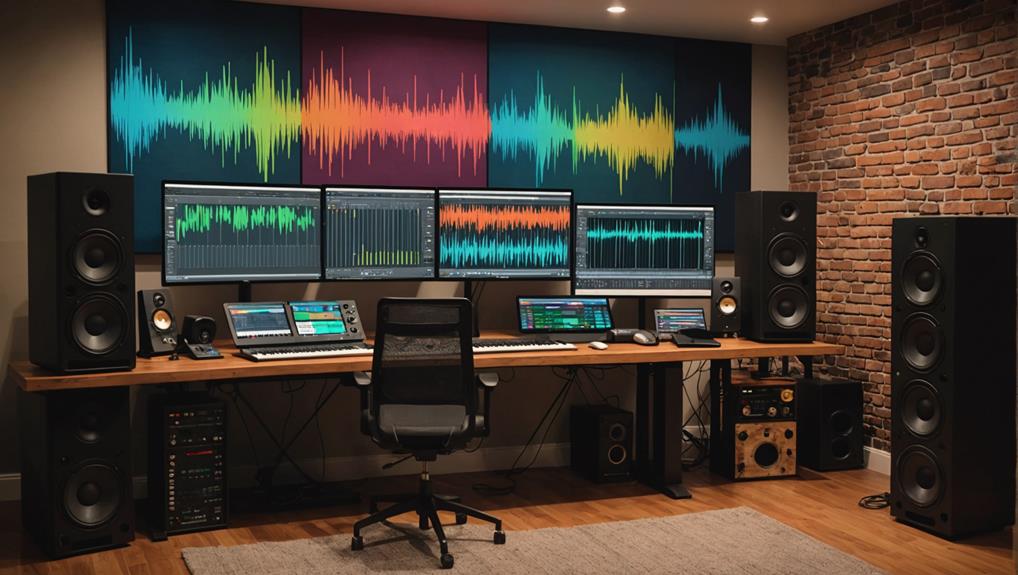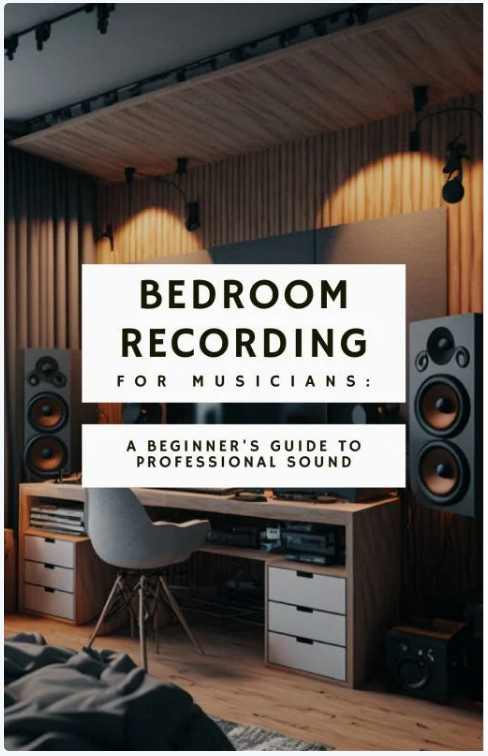To streamline your home studio mixing process, start by organizing your tracks clearly in your Digital Audio Workstation. Mute tracks one by one to determine their necessity, and use EQ and compression to manage sound effectively. Begin mixing in mono to guarantee a balanced mix, and regularly reference your work on different playback systems. Invest in quality tools, such as studio monitors and essential plugins, to enhance sound quality. With a confident mindset and iterative approach, you’ll refine your mixing skills. Stick around to discover more tips and techniques for optimizing your mixing workflow.
Key Takeaways
- Export individual audio tracks for clarity and ease in mixing, allowing for focused adjustments without confusion.
- Organize your DAW with labeled track groups and a clear file structure to streamline access and enhance workflow efficiency.
- Start mixing in mono to identify imbalances and ensure a well-balanced frequency spectrum before adding stereo effects.
- Regularly reference your mix on different playback systems to ensure it translates well across various environments.
Preparation for Mixing
Before you plunge into mixing, it’s crucial to prepare your tracks properly to guarantee a clear and professional sound. Start by exporting all recorded or programmed tracks as individual audio files. This approach enhances clarity and streamlines the mixing process, allowing you to work with one audio file per track for professional results.
Next, reassess the arrangement of your tracks. Identify and eliminate any clashing sounds; a well-organized arrangement can often lead to a mix that practically mixes itself. To further clarify the essentials, mute tracks one by one. This helps you evaluate their impact on the overall sound and determine which elements are truly necessary.
Setting your mixer to mono during your preparation for mixing can also reveal potential issues. This practice helps you identify imbalances that mightn’t be obvious in stereo. By organizing and preparing your tracks as if a professional mix engineer is handling them, you greatly improve your mixing outcome and enhance overall clarity.
Taking these steps guarantees that your mixing music process starts on a solid foundation, ultimately leading to a more polished final product.
Essential Mixing Tools
Now that your tracks are properly prepared, having the right mixing tools at your disposal will make all the difference in achieving a professional sound.
Here’s a quick rundown of the essentials you’ll need for mixing your audio tracks effectively:
- Digital Audio Workstation (DAW): Choose a DAW like Pro Tools or Logic Pro to serve as your central hub for mixing.
- Plugins: Invest in essential plugins, including EQ, compression, and reverb, to enhance sound quality and achieve a balanced mix.
- Studio Monitors: Use quality studio monitors, such as the Yamaha HS series, for accurate sound representation and to guarantee your mixes translate well across different playback systems.
Don’t forget about acoustic treatment! Implementing bass traps and diffusers in your home studio will help minimize unwanted reflections and resonances, leading to a more accurate mixing environment.
With these tools, you’re primed to create mixes that sound polished and professional.
Mixing Techniques and Strategies

To achieve a polished mix, mastering effective mixing techniques and strategies is crucial for enhancing the clarity and balance of your tracks.
Start your mixing process in mono to assess frequency balance and identify potential clashing sounds. This approach helps guarantee a clearer stereo mix later on.
Utilize EQ techniques by sweeping through frequencies to find and eliminate unwanted frequencies. After identifying these unpleasant sounds, reset the gain to zero for a cleaner mix.
Experimenting with panning while still in mono will help you determine ideal placements for instruments, creating a more defined stereo image when you shift to stereo mixing.
Compression is another essential tool in your arsenal. It helps manage dynamic range and maintain consistent levels across different instruments, enhancing overall balance.
Don’t forget to regularly reference your mix on various playback systems. Different environments can reveal issues that mightn’t be apparent in your studio setup, securing clarity and cohesion in your music mixing.
Mindset for Successful Mixing
A positive mindset can considerably enhance your mixing experience, helping you approach the process with confidence and intentionality.
As a mix engineer, it’s essential to view mixing not just as a technical task but as an opportunity for creativity and personal expression.
Here are some key points to keep in mind:
- Embrace your role as a mix engineer and trust your instincts.
- Treat mixing as an iterative process, allowing for experimentation and growth.
- Prioritize your personal taste to create unique sounds that resonate.
Organizing Your Studio

Organizing your studio effectively sets the foundation for a smoother mixing process and boosts your overall productivity. Start by establishing a clear file structure for your music projects. Organizing tracks and assets by genre or project type enhances workflow efficiency and prevents confusion when you’re deep into mixing.
In your DAW, utilize labeled track groups to categorize instruments like drums, vocals, and guitars. This makes accessing and processing these tracks easier during your sessions. Keep your workspace clutter-free: balance accessibility with organization so that essential tools are within reach while minimizing distractions.
Don’t forget to regularly back up your project files. This protects against loss of work and allows you to maintain multiple versions, making it easy to retrieve previous mix stages if needed.
Additionally, implement acoustic treatment in your home studio. Adding elements like bass traps and diffusers will improve sound quality, ultimately enhancing your ability to make accurate mixing decisions.
Engaging With the Community
Connecting with the audio production community can greatly enhance your mixing skills and inspire new ideas. By engaging with others, you’ll receive valuable feedback and insights that can refine your techniques.
Here are some effective ways to connect and grow:
- Join online forums where music producers share tips and tricks.
- Participate in social media groups to showcase your mixes and get constructive criticism.
- Attend local meetups or webinars for hands-on learning with industry experts.
Being active in these communities keeps you updated on the latest tools and techniques, ensuring you’re always improving.
You’ll find that sharing your work not only builds your confidence but also fosters relationships with experienced professionals.
Plus, discussing your mixing challenges can lead to fresh perspectives, enriching your projects.


